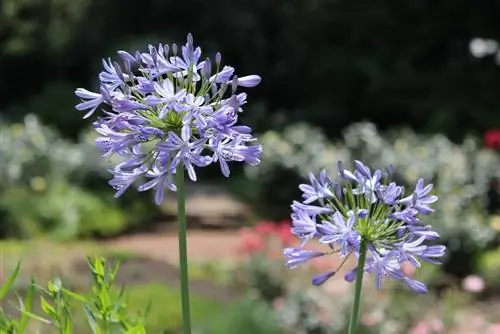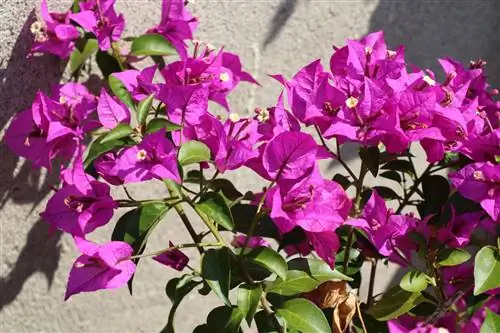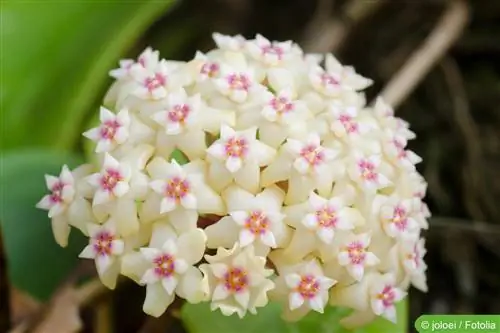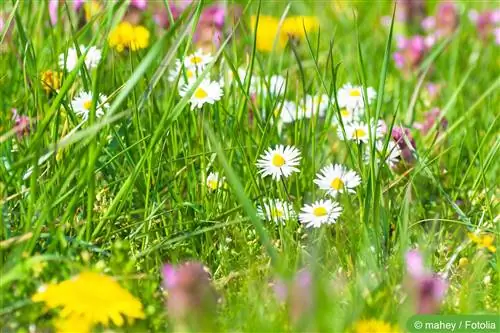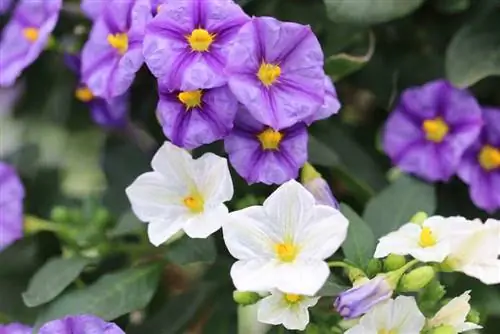- Author admin [email protected].
- Public 2023-12-17 03:39.
- Last modified 2025-06-01 06:48.
Over 1,000 varieties of the love flower are cultivated today. Its name is derived from its botanical name Agapanthus, agape=love and anthos=flower. It is often also called the African lily. The solitary plant does not require much care when it comes to care. From the beginning of April until autumn it needs a sunny spot outdoors, and in winter a winter quarters that are not too warm. Thank you for a lush display of flowers.
Location & plant substrate
The African lily's homeland is southern Africa, so it can't get enough sun. It is undemanding when it comes to location. As a container plant, it is happy in almost any place.
- Sunny to full sun
- Partial shade to shade: A few hours of sunshine daily
- Commercial potting soil
- Add permanent fertilizer, sand and clay soil
- Create gravel, expanded clay or lava grit at the bottom of the pot as a drainage layer
The flowers of the love flower tolerate rain well. If it rains a lot and intensively, it is an advantage if faded individual flowers are plucked off. This prevents rot. Evergreen varieties are considered wind-resistant, others need a location protected from the wind so that the flower stalks do not break in the wind. If the African lily becomes too large in one location or you need space for another plant - that's not a problem for the love flower. Then simply move the potted plant around.
Tip:
Place the plant in the sun rather than the shade. In shady locations, their flower stalks seek the sun, i.e. they grow towards the sun, which doesn't always look nice. In addition, the colors of the flowers fade quickly in shady locations.
Solitary or in groups?
Visually, the love flower with its long flower stalks looks best as a solitary plant. A small group of plants is also attractive.
Plants
The African lily is a very popular potted plant because it is very robust and easy to care for. Annual repotting is not necessary. However, if the root ball pushes slightly over the edge of the pot, it is time to repot. Although Agapanthus blooms most profusely when the planter is completely rooted, if it becomes too narrow for the plant, it can no longer absorb enough water. Then she starts to worry and stops growing. The new bucket should be a little larger than the old one. This means the African lily can root through it more quickly. The plant usually needs a year of repotting to get used to its new home. It will only show its full bloom again in the season after repotting.
- Repotting in spring before budding out
- Place the root ball in a larger container
Substrate: normal potting or potting soil
- Good water drainage at the bottom of the pot with or without a saucer
- Don’t forget the drainage layer
Tip:
The African lily blooms most beautifully when it can grow undisturbed. Only repot the plant if the pot has really become too small. Do not use ceramic pots. Often the pot has to be destroyed to get the plants out.
Planting out in the garden
Planting in the garden is not recommended as the African lily is not hardy. In addition, wet soil causes problems: waterlogging is the love flower's greatest enemy. If wet soil causes the root ball to freeze, the plant can no longer be saved. In individual cases, however, summer green love flowers can survive milder German winters when planted out. The prerequisites are very good water drainage, i.e. an extremely permeable soil, a winter cover with mulch and moisture protection.
Planting out with a pot
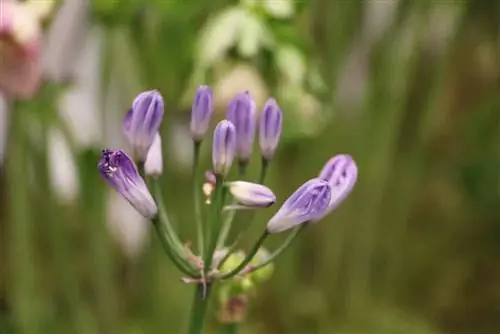
African lilies can of course be planted in pots, but only as long as they are not grown in a wooden pot. Before the first frost, the plants should be dug up again and placed in their winter quarters.
Watering & Fertilizing
The water requirement of the love flower is rather modest. This means she can survive without water for two weeks at a time. This does not leave the plant unscathed, it loses some of its leaves, but it recovers quickly after the dry period. Too much water damages the plant. Buckets, pots and also coasters should always have drainage holes.
When watering and fertilizing, the following should be observed:
- Low water requirement, but water regularly from April
- Waterlogging is fatal for the plant
- Add slow-release fertilizer when repotting or fertilize every four weeks from April to the beginning of August
- Normal liquid fertilizer is sufficient
Tip:
Wait until the top layer of soil has dried thoroughly before watering again.
Leaves, flowers & growth
Agapanthus is available as a summer and evergreen plant, although evergreen varieties develop slightly larger leaves and flowers. The flowering period is short but intense. Their flower colors range from white to blue to dark purple. Depending on the variety, the leaves can be completely green, edged with white or striped.
- Long, narrow leaves, between 20 and 100 centimeters
- Ornamental onion-like, spherical flowers
- Flowers filled or unfilled
- Flower color: white, purple, blue or dark purple - in all shades in between
- Flowering period from July to mid-August
- Almost no scent
- Height: from 20 centimeters for balcony boxes to shapes with 2 meter long flower stems
Tip:
To ensure that the “real” African lily blooms in your garden, it is best to buy it in bloom.
Cutting
The African lily does not need any pruning or shaping. Only dead flowers should be cut off, if possible before seeds form. This is how the plant puts its energy into the formation of new flowers. Dried leaves are not cut off, but torn off. On deciduous plants, not all dead leaves should be removed in autumn. The old leaves protect the new shoots in spring.
Tip:
The flowers also look pretty in the vase. Carefully cut off the long flower stalks, their sap can cause stubborn stains on textiles.
Wintering
Agapanthus is not frost resistant. When overwintering the African lily, a distinction must be made between summer and evergreen plants. Evergreen African lilies cannot tolerate frost at all. The winter quarters must be dry and light. The temperature should not exceed seven degrees Celsius. If the winter quarters are too warm, Agapanthus will not bloom as profusely after wintering.
Summer green love flowers lose their leaves in winter. They can therefore hibernate in the dark. However, with the beginning of spring, when the plant begins to sprout, it needs light. The winter quarters should be dry and cool like evergreen plants.
The following applies to summer and evergreen love flowers:
- Keep root balls dry
- Wate little or not at all from November to March
Do not fertilize during winter rest
Watering regularly again from April
Even if the love flower is not very frost-resistant, it should be brought back outdoors soon after the winter. If there are no more severe frosts to be expected, the outdoor season can begin. If, contrary to expectations, frost occurs, bring the plant back into the house or protect it with a fleece. Under these conditions, the African lily can be placed outdoors at the beginning of April.
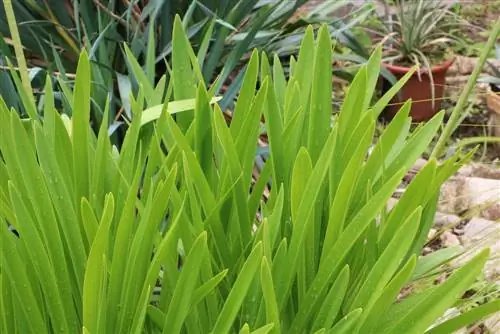
To avoid burning the leaves due to UV light, it is best to put the love flower in a shady spot after wintering. Once the plant has got used to the sun after a week, depending on the weather, it can move to its summer location.
Propagate
As a perennial, Agapanthus is propagated by division or sowing seeds. When a plant is divided, the parts have the same properties as the original plant. If the parts are divided after a few years, they have the same properties as the original parts. In short, when divided, the properties always go back to the first, undivided, acquired plant.
Seedlings are grown from the seeds of the love flower. They are independent plants and have their own individual characteristics. They are essentially “children” who have more or less taken on the characteristics of their “parents”.
Propagation by seeds
Propagation by seeds is not a problem, but requires patience, as deciduous African lilies only begin to bloom after two years at the earliest, but usually only after three to four years. Evergreen plants only bloom after five years and some large-flowered species even after six or seven. If blue and white varieties are grown together, the appearance cannot be predicted, as not even the color can be predicted.
- Harvest ripe seeds in autumn
- Store dry and cool until spring
- Sowing at 15 degrees
- Slightly cover
- Germination after 2 to 4 weeks
- After another 2 months, place seedlings in individual pots
- Ensure dry and frost-free wintering
- Repot young plants every year
Reproduction by division
When propagating by division, faster success is achieved when it comes to flowering. Old, large plants should definitely be divided as this stimulates their growth. In addition, sharing acts as a rejuvenation treatment for the plants.
- Cut the root ball with a sharp knife
- Divide larger plants with an ax or spade
- Time: March to April
- Place individual parts in suitable buckets
- Water carefully in the first few weeks
The African lily is not known to have been released into the wild. If seeds form, they will not sprout in the garden. Our winters are too cold for that.
Tip:
Buy a seedling when it blooms so that the appearance of the plant meets your expectations. If you want to have exactly the same agapanthus as friends or neighbors, then the plant should be divided.
Diseases & Pests
Pest infestation is not known for the African lily. Their pungent plant sap also keeps snails or mice away. It reacts very sensitively to waterlogging and can even “kill” the robust plant.
Toxicity
Agapanthus is not intended for consumption, although the plant is not poisonous in small quantities. You should be particularly careful if the plant is injured, for example when the flower stalks are cut off. The plant then secretes a mucous-like fluid containing saponins. This can cause skin irritation and allergic reactions in humans. Direct contact with eyes or mouth should be avoided. The plant sap causes stains on clothing that are difficult or impossible to remove. Therefore, make sure you wear the right clothing when working with the love flower.
Interesting facts about the love flower
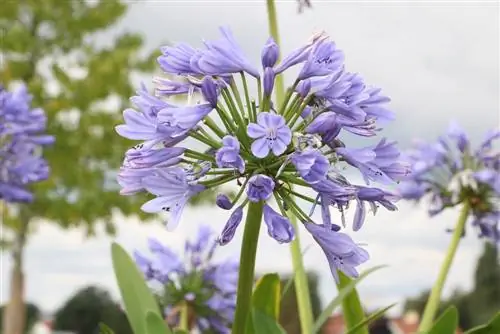
Agapanthus has graced gardens for centuries. Especially in the Baroque era, the plant was a must in every garden of a palace or residence. Today the island of Madeira is known for the agapanthus flower. Many insects enjoy the flower of the African lily, especially bumblebees love this plant.
Conclusion
With its long flower stalks, the love flower makes a magnificent impression on the balcony or terrace. Depending on the variety, it has umbel flowers with many individual flowers in a wide variety of colors from white to dark purple. The love flower develops strong, fleshy roots so that it can survive even longer dry periods. However, it cannot tolerate waterlogging at all. Pots or buckets or their saucers must be provided with drainage holes. Planting it in the garden is not recommended because the African lily is not hardy or even frost-resistant. Depending on the variety, it overwinters in light or dark conditions, in any case dry and not too warm. Agapanthus prefers to grow undisturbed, so the plant does not need to be repotted every year. The African lily is non-poisonous, but should not be consumed. You should be careful when working with the plant. Not only can their sap irritate the skin, eyes or mouth, it also makes stains on clothing that cannot be removed. Ecologically speaking, it is a playground for many useful insects, especially bumblebees love the African lily.

